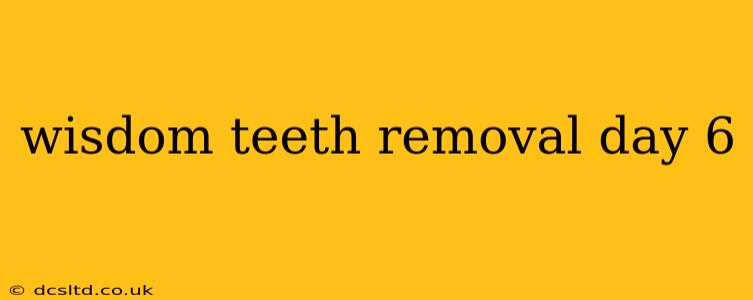So, you're on day six post-wisdom teeth removal. Congratulations on making it this far! The initial pain and swelling should be starting to subside, but recovery is a journey, not a sprint. This post will guide you through what's typical on day six, address common concerns, and offer tips to continue your healing process smoothly.
What is Normal on Day 6 After Wisdom Teeth Removal?
By day six, the most intense pain should have diminished significantly. You might still experience some discomfort, especially when chewing or opening your mouth wide, but over-the-counter pain relievers should manage this effectively. The swelling should also be reducing, though some puffiness might remain. You might notice some bruising around the surgical site. Your mouth might still feel numb in patches, but this numbness is gradually resolving. Finally, you'll likely continue to see some blood-tinged saliva or drainage. This is a normal part of the healing process.
Is it Okay to Eat Solid Food on Day 6 After Wisdom Teeth Removal?
This depends heavily on your individual situation and your oral surgeon's instructions. While some people can gradually reintroduce soft foods by day six, others may need to stick to liquids or very soft foods for longer. It's crucial to follow your surgeon's advice. Generally, avoid anything that requires excessive chewing or could irritate the extraction sites. Think mashed potatoes, applesauce, yogurt—nothing crunchy, hard, or sticky.
How Much Swelling is Normal on Day 6 After Wisdom Teeth Removal?
While swelling typically peaks around day 2-3, some residual swelling on day six is common. If the swelling is significantly increasing instead of decreasing, or if it’s accompanied by severe pain, fever, or excessive bleeding, contact your oral surgeon immediately. This could indicate an infection or other complication.
What if I Still Have a Lot of Pain on Day 6 After Wisdom Teeth Removal?
Persistent, severe pain on day six isn't necessarily unusual, but it warrants a call to your oral surgeon. They can assess whether the pain is within the expected range of post-operative discomfort or if a complication needs attention. Don't suffer in silence – reach out for guidance.
How Long Does it Take for Wisdom Teeth Sockets to Heal?
Complete healing of the wisdom teeth sockets usually takes several weeks, sometimes even months. The initial stages of healing are the most critical, with the sockets typically closing within the first week or two. However, the bone will continue to regenerate and fully heal over several months.
When Can I Resume Normal Activities After Wisdom Teeth Removal?
Most people can return to light activities like walking or gentle desk work within a few days. However, strenuous activities, heavy lifting, or intense exercise should be avoided for at least a week, or as advised by your oral surgeon. This is to prevent dislodging blood clots and hindering healing.
Day 6 After Wisdom Teeth Removal: Dry Socket Concerns
A dry socket is a complication where the blood clot protecting the extraction site is dislodged or dissolves prematurely. On day six, the risk of a dry socket is reduced, but it's still important to be vigilant. If you experience intense, throbbing pain, a bad taste in your mouth, or a visible empty socket, contact your oral surgeon immediately.
Conclusion: Your Wisdom Teeth Recovery Journey
Day six after wisdom teeth removal is a significant milestone in your recovery. While some discomfort and swelling are to be expected, persistent, severe pain, excessive bleeding, or unusual symptoms need prompt medical attention. Remember to follow your oral surgeon's instructions carefully, maintain good oral hygiene (as directed), and prioritize rest to ensure a swift and complete recovery. If you have any concerns, don't hesitate to contact your oral surgeon or dentist. They are your best resource during this healing period.
